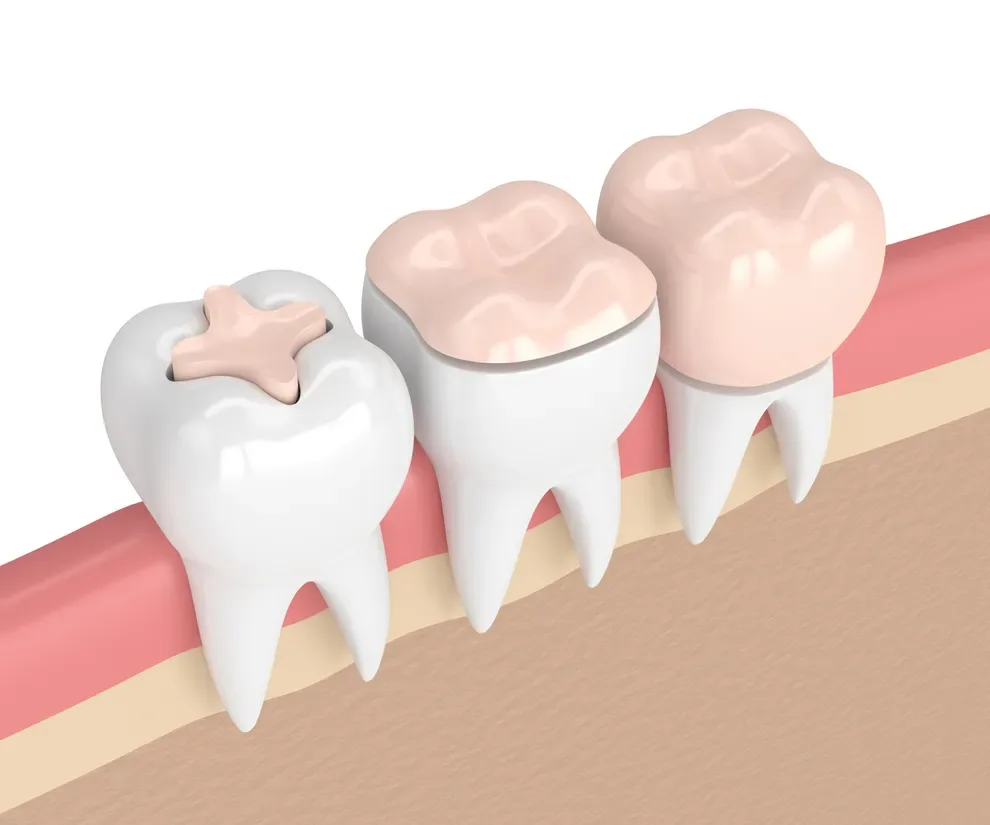Dental Inlays and Onlays: What Is the Difference?

Table of Contents
- What Are Dental Inlays & Onlays?
- What They Treat
- Materials
- Differences
- The Procedures
- Recovery & Aftercare
- Costs
- Frequently Asked Questions
- References
Inlays and onlays are common dental restorations used to restore the structure of a damaged tooth. They provide a middle ground between basic restorations like fillings and aggressive treatment options like crowns.
The decision to use an inlay or an onlay depends on the location and severity of the tooth damage. Inlays treat extensive internal damage, while onlays treat surface deterioration.
What Are Dental Inlays and Onlays?
Dental inlays and onlays allow dentists to restore extensive tooth damaged teeth without needing to resort to a full-coverage crown. They are indirect restorations that are custom-made to fill in areas of a tooth that have been damaged by injury, wear, or decay.
Inlays and onlays can be used to treat any teeth with a biting surface, including both molars and premolars. They help keep a damaged tooth intact for longer, allow the patient to enjoy full use of that tooth when eating and speaking, and often produce appealing cosmetic results.
Dental Inlays
Dental inlays are typically made of ceramic, porcelain, or resin composite material. They are designed to fit perfectly into a hole in a tooth that was created by injury or decay.
Inlays are very strong and are considered to be a superior restorative option compared to fillings. They can be made to closely match the color of your teeth, making them a discreet option for treating more significant dental damage.
Dental Onlays
Onlays are often used to restore teeth with damaged or decayed cusps. They can be used in situations where a filling would not provide enough structural strength to keep the tooth from breaking. They were once made exclusively out of metal but can now be made from porcelain or resin composite materials. Onlays are usually much larger than inlays. Some of the biggest onlays look a lot like short dental crowns, covering all four cusps of the tooth but not its sides.
What Do Inlays and Onlays Treat?
Dental professionals use inlays and onlays to treat tooth decay, damage, or erosion that is too advanced for a basic filling but not severe enough to warrant a crown.
Inlays are frequently used to treat large cavities that are located in the area between the tooth’s cusps.
Onlays can also be used to treat decay, but they have other common applications as well. They are often used to repair teeth whose cusps have been damaged by excessive wear or acid erosion.
Both are generally useful for restoring the shape of a tooth and preventing further damage.
Inlay and Onlay Materials
Gold, ceramic, and composite materials are the most popular materials used to make inlays and onlays.
Many dentists and manufacturers use gold for inlays and onlays due to gold’s strength and durability. Teeth with frequent fractures are great candidates for gold inlays since gold offers excellent protection against future breakage.
Aesthetics are the main drawback to gold inlays and onlays. Gold restorations are best suited for back teeth where they won’t be easily visible in most instances.
Advantages
Stain-resistant
Durable
Malleable
Strong enough to withstand fracturing
Disadvantages
Conspicuous
Expensive
Ceramics (including porcelain) are used to create tooth-colored inlays and onlays. This material provides outstanding aesthetic results, but it requires a little more upkeep compared to other options.
Advantages
Durable, especially when fused to metal
Tooth-colored
Can be made to mimic tooth translucency, creating a more convincing cosmetic result
Disadvantages
May chip easily
Prone to staining
Rigid
Inlays and onlays made of resin composite are the best candidates to fill large cavities. Restorations made from this material are affordable, long-lasting, and blend in well with natural teeth.
Advantages
Durable
Lower cost
Tooth-colored
Disadvantages
Weaker than gold
Rigid
Prone to staining
Differences Between Inlays, Onlays and Crowns
The primary difference between an inlay and onlay is where the restoration is placed. An inlay sits in the middle of the tooth where the pits and fissures once were. An onlay covers at least one cusp of the tooth as well as the pits and fissures in some cases.
A dental crown, on the other hand, covers the entire tooth, including the full biting surface and all sides. Crowns provide full coverage and can be used to change the shape of a tooth, if needed.
However, crowns require dentists to remove significant amounts of tooth structure before they can be placed. Inlays and onlays are more conservative treatment options that provide similar benefits to crowns while allowing the patient to keep more of their tooth intact.
Step by Step Inlay and Onlay Procedure
There are five main steps required to install an inlay or onlay.
Step 1: Your dentist will remove the damaged portion of the tooth. This step is done using a dental drill and is identical to what would happen if you were receiving a regular dental filling.
Step 2: Your dentist will place the base to support the mold, then take an impression of your tooth to send to the lab.
Step 3: Your dentist will place a temporary inlay or onlay to cover your tooth while you wait for the restoration.
Step 4: The lab creates a restoration from the mold and sends it back to your dentist.
Step 5: Your dentist will install your restoration at your next appointment. This is typically done a few weeks later.
Recovery and Aftercare
After your inlay or onlay is installed, your dentist will give you a list of aftercare instructions to follow. They will likely advise you to avoid eating until the anesthetic wears off. Take special care to avoid hard foods such as peanuts, apples, and carrots for around 24 hours.
Your dentist will also give you directions on flossing or brushing after the procedure. Expect some minor discomfort, especially after an onlay installation. This sensation may last for up to a few weeks depending on how deep and extensive the restoration is.
Inlay and Onlay Costs
Inlays and onlays cost more than basic restorations like dental fillings. Onlays usually cost a little more than inlays due to their larger size.
Inlays or onlays made from higher-quality materials like porcelain, zirconia, or gold cost more than those made of materials like composite resin. Your dentist’s experience, practice location, and reputation also influence the cost of these restorations.
Frequently Asked Questions
Both inlays and onlays offer long-term solutions for repairing dental damage, but they are used to treat different types of problems. Your dentist will recommend one or the other based on your treatment needs.
The main difference between inlays and onlays is their position. Inlays cover the pits and fissures of a tooth while onlays cover one or more cusps.
